2012 Peugeot 508 RXH airbag off
[x] Cancel search: airbag offPage 20 of 304
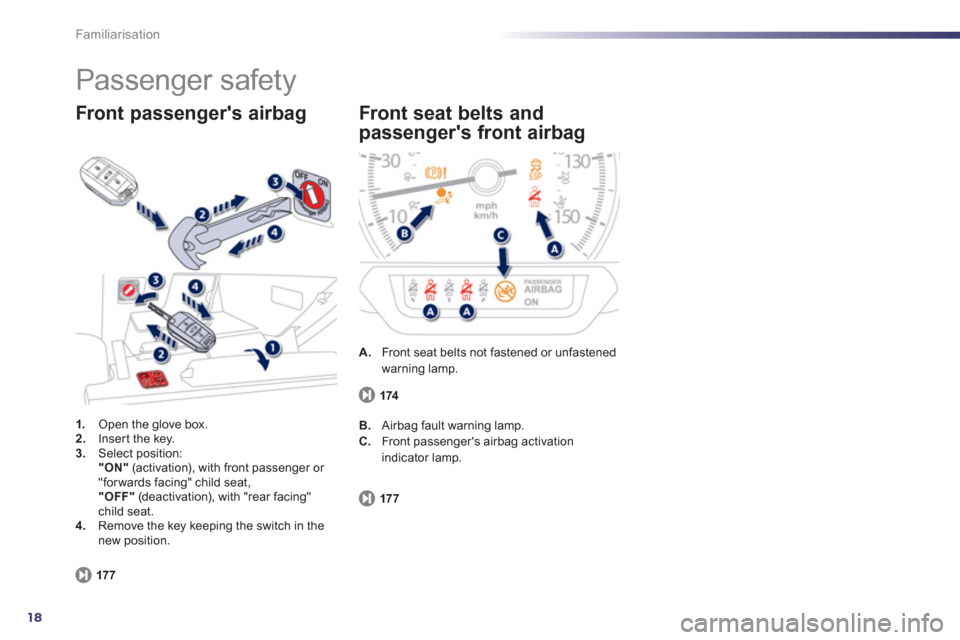
18
Familiarisation
Passenger safety
1.
Open the glove box.2.
Inser t the key.3.Select position:
"ON"
(activation), with front passenger or "forwards facing" child seat,
"OFF"
(deactivation), with "rear facing" child seat.4.
Remove the key keeping the switch in the new position.
Front passenger's airbag
177
A.
Front seat belts not fastened or unfastenedwarning lamp.
Front seat belts and
passenger's front airbag
177 B
. Airbag fault warning lamp.
C.
Front passenger's airbag activation indicator lamp.
174
Page 51 of 304
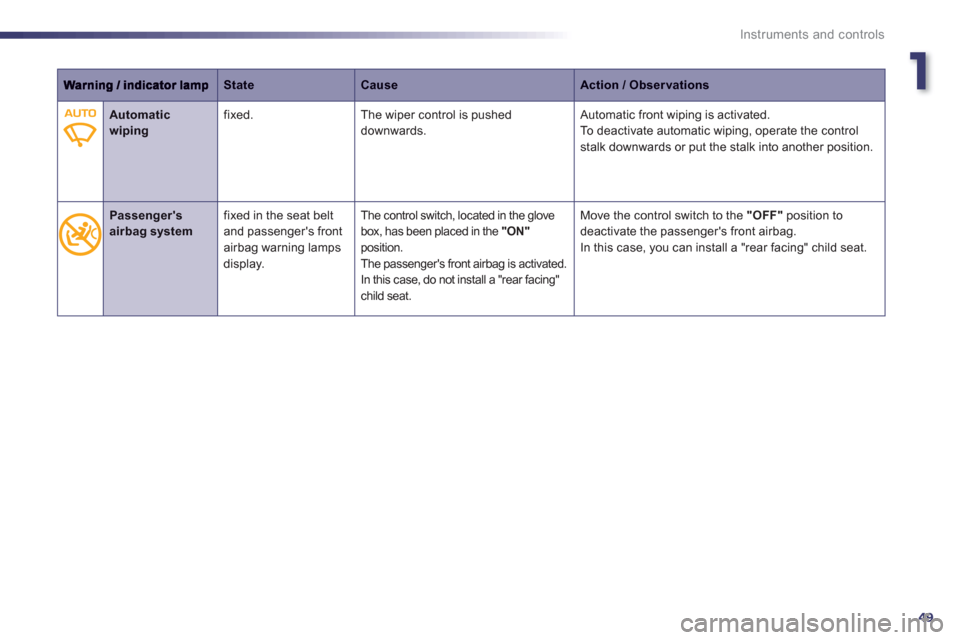
1
49
Instruments and controls
StateCauseAction / Observations
Automatic wiping
fixed. The wiper control is pushed downwards. Automatic front wiping is activated.
To deactivate automatic wiping, operate the controlstalk downwards or put the stalk into another position.
Passenger's airbag system fixed in the seat belt
and passenger's front
airbag warning lampsdisplay.
The control switch, located in the glove box, has been placed in the "ON" position.
The passenger's front airbag is activated. In this case, do not install a "rear facing"child seat.
Move the control switch to the "OFF"
position to
deactivate the passenger's front airbag.
In this case, you can install a "rear facing" child seat.
Page 52 of 304
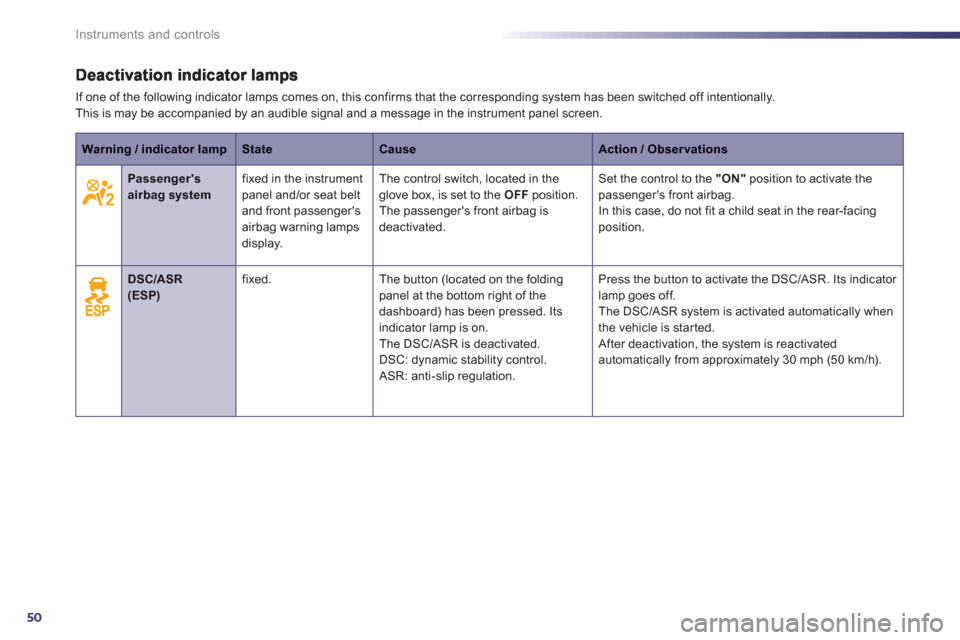
50
Instruments and controls
If one of the following indicator lamps comes on, this confirms that the corresponding system has been switched off intentionally.This is may be accompanied by an audible signal and a message in the instrument panel screen.
Warning / indicator lampStateCauseAction / Observations
Passenger's airbag systemfixed in the instrumentpanel and/or seat beltand front passenger's airbag warning lamps
display.
The control switch, located in the glove box, is set to the OFF
position.
The passenger's front airbag is deactivated.
Set the control to the "ON"
position to activate the passenger's front airbag.
In this case, do not fit a child seat in the rear-facing position.
DSC/ASR(ESP)fixed. The button (located on the foldingpanel at the bottom right of the
dashboard) has been pressed. Its
indicator lamp is on.
The DSC/ASR is deactivated.
DSC: d
ynamic stability control.
ASR: anti-slip regulation.Pr
ess the button to activate the DSC/ASR. Its indicator
lamp goes off.
The DSC/ASR system is activated automatically when
the vehicle is started.
After deactivation, the system is reactivated
automatically from approximately 30 mph (50 km/h).
Page 58 of 304

56
Instruments and controls
Warning / indicator lampStateCauseAction / Observations
Airbagson temporarily. This lamp comes on for a fewseconds when you turn on
the ignition, then goes off.This lamp should
go off when the engine is started.
If it does not go off, contact a PEUGEOT dealer or a
qualified workshop.
fixed.One of the airbag or seat beltpretensioner systems has a fault.Have it checked by a PEUGEOT dealer or a qualified
workshop.
Directionalheadlampsflashing. The directional headlamps systemhas a fault.Have it checked by a PEUGEOT dealer or a qualified
workshop.
Seat belt(s) not fastened / unfastenedfixed then flashin
gaccompanied by anincreasing audible
signal. A
seat belt has not been fastened or has been unfastened.Pull the strap then inser t the tongue in the buckle.
Page 60 of 304

58
Instruments and controls
*
According to country.
CHECK (vehicle autotest)
Automatic CHECK
With the key in the ignition on position, all of the
warning lamps for the functions tested are displayed.
They are switched off after a few seconds.
At the same time, an automatic CHECK (vehicle
autotest) is carried out.
In the presence of a fault
A "minor" fault has been detected: the warning
lamp(s) are displayed then go off.You can star t your vehicle; however, contact a
PEUGEOT dealer or a qualified workshop assoon as possible.
A "major" fault has been detected: theassociated warning lamps(s) remain onaccompanied by the STOP or SERVICE
warning lamp.
Do not star t your vehicle. Call a PEUGEOT dealer or a qualified
wor
kshop without delay.
Manual CHECK
Pressing the "CHECK"
button on theinstrument panel star ts the manual CHECK(vehicle autotest).
This function enables you to recall at any time(with the key in the ignition on position or with
the engine running), the aler ts present.
The passenger's airbag deactivated warning lamp * remains on while the airbag is deactivated.
With the engine running and the vehiclemoving, the instrument panel displays
the
warning lamps (in the event of a fault). I
f no "major" fault is found, you can star t your
vehicle.
Lighting dimmer control
With the headlamps on, press button B
to
increase the brightness of the instruments and controls and the interior mood lighting or button Ato reduce it.
As soon as the lighting reaches the required
level of brightness, release the button.
Page 162 of 304
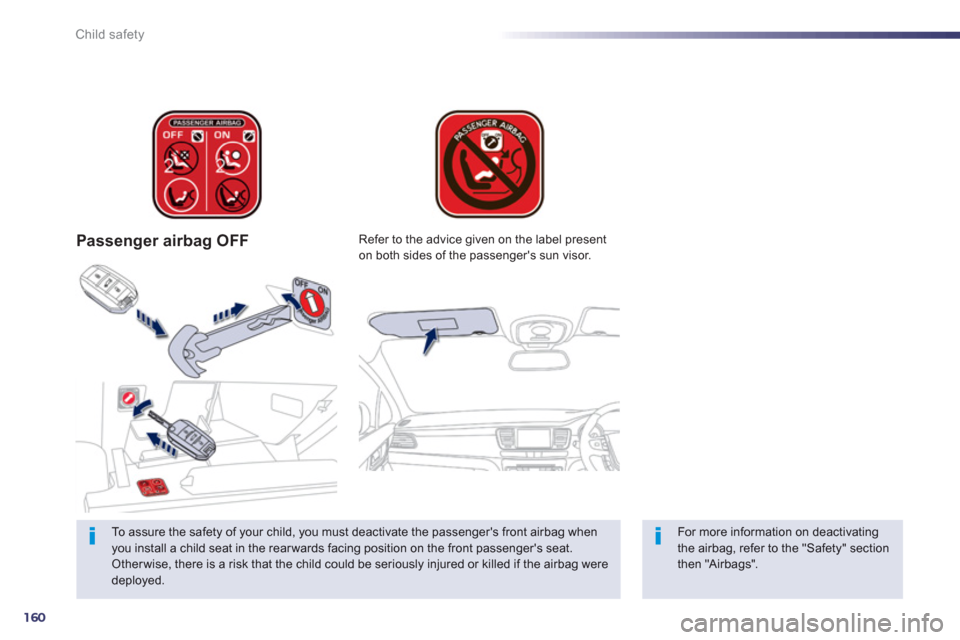
160
Child safety
Passenger airbag OFF
To assure the safety of your child, you must deactivate the passenger's front airbag when
you install a child seat in the rear wards facing position on the front passenger's seat. Other wise, there is a risk that the child could be seriously injured or killed if the airbag weredeployed.
Re
fer to the advice given on the label present
on both sides of the passenger's sun visor.
For more information on deactivating
the airbag, refer to the "Safety" sectionthen "Airbags".
Page 177 of 304
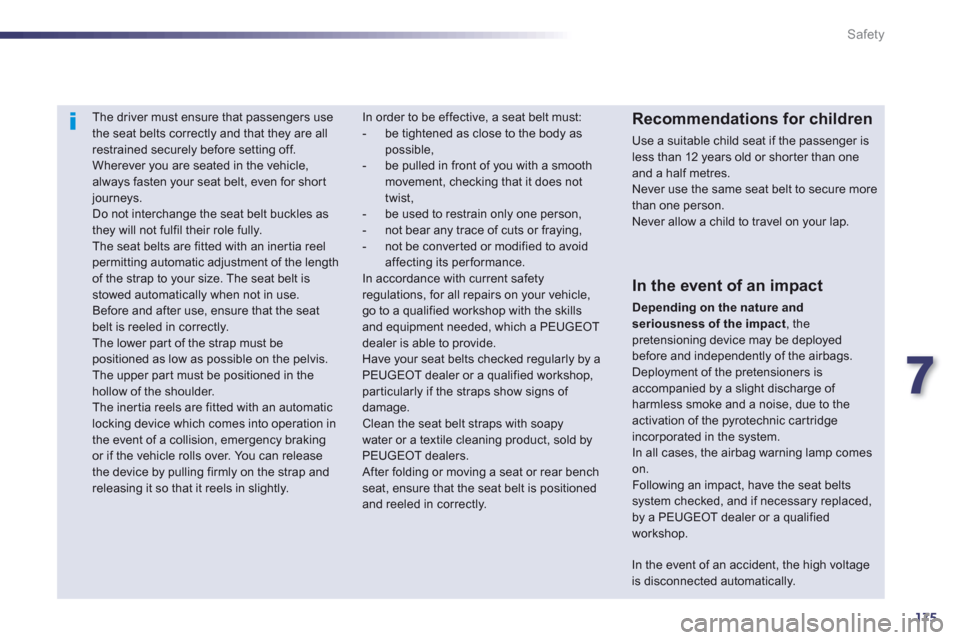
7
175
Safety
The driver must ensure that passengers usethe seat belts correctly and that they are allrestrained securely before setting off.
Wherever you are seated in the vehicle, always fasten your seat belt, even for short journeys.
Do not interchange the seat belt buckles asthey will not fulfil their role fully.
The seat belts are fitted with an inertia reel permitting automatic adjustment of the length of the strap to your size. The seat belt isstowed automatically when not in use.
Before and after use, ensure that the seatbelt is reeled in correctly.
The lower par t of the strap must bepositioned as low as possible on the pelvis.
The upper par t must be positioned in the hollow of the shoulder.
The inertia reels are fitted with an automatic locking device which comes into operation inthe event of a collision, emergency braking or if the vehicle rolls over. You can releasethe device by pulling firmly on the strap and releasing it so that it reels in slightly.
Recommendations for children
Use a suitable child seat if the passenger isless than 12 years old or shor ter than one and a half metres. Never use the same seat belt to secure morethan one person. Never allow a child to travel on your lap.
In order to be effective, a seat belt must:
- be tightened as close to the body as possible,
- be pulled in front of you with a smooth movement, checking that it does nottwist,
- be used to restrain only one person,
- not bear any trace of cuts or fraying,
- not be converted or modified to avoid affecting its per formance.
In accordance with current safety regulations, for all repairs on your vehicle, go to a qualified workshop with the skills and equipment needed, which a PEUGEOT dealer is able to provide.
Have your seat belts checked regularly by a PEUGEOT dealer or a qualified workshop, particularly if the straps show signs of damage.
Clean the seat belt straps with soapywater or a textile cleaning product, sold by PEUGEOT dealers.
After folding or moving a seat or rear bench seat, ensure that the seat belt is positioned and reeled in correctly.
In the event of an impact
Depending on the nature and seriousness of the impact
, thepretensioning device may be deployedbefore and independently of the airbags.Deployment of the pretensioners isaccompanied by a slight discharge of harmless smoke and a noise, due to theactivation of the pyrotechnic cartridgeincorporated in the system.In all cases, the airbag warning lamp comes on.Following an impact, have the seat belts system checked, and if necessary replaced,by a PEUGEOT dealer or a qualified
workshop.
In the event of an accident, the high voltageis disconnected automatically.
Page 178 of 304
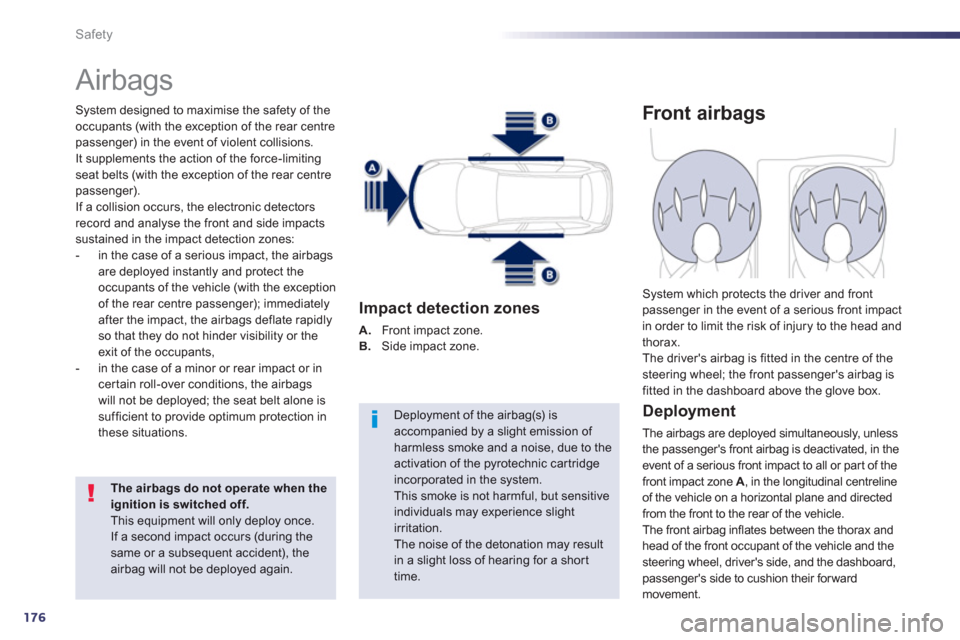
176
Safety
Airbags
System designed to maximise the safety of the
occupants (with the exception of the rear centrepassenger) in the event of violent collisions.
It supplements the action of the force-limiting seat belts (with the exception of the rear centrepassenger).
If a collision occurs, the electronic detectors record and analyse the front and side impacts sustained in the impact detection zones:
- in the case of a serious impact, the airbagsare deployed instantly and protect the
occupants of the vehicle (with the exception
of the rear centre passenger); immediately after the impact, the airbags deflate rapidlyso that they do not hinder visibility or the
exit of the occupants,
- in the case of a minor or rear impact or incer tain roll-over conditions, the airbags
will not be deployed; the seat belt alone is
sufficient to provide optimum protection in
th
ese situations.
The airbags do not operate when the ignition is switched off. This equipment will only deploy once.
If a second impact occurs (during thesame or a subsequent accident), theairbag will not be deployed again.
Deployment of the airbag(s) is accompanied by a slight emission of harmless smoke and a noise, due to theactivation of the pyrotechnic cartridgeincorporated in the system.This smoke is not harmful, but sensitiveindividuals may experience slight irritation.
The noise of the detonation may result in a slight loss of hearing for a shorttime.
Impact detection zones
A.
Front impact zone. B.
Side impact zone.
Front airbags
Deployment
The airbags are deployed simultaneously, unless
the passenger's front airbag is deactivated, in the event of a serious front impact to all or part of thefront impact zone A, in the longitudinal centreline
of the vehicle on a horizontal plane and directedfrom the front to the rear of the vehicle.
The front airbag inflates between the thorax andhead of the front occupant of the vehicle and thesteering wheel, driver's side, and the dashboard,passenger's side to cushion their for ward movement.
System which protects the driver and frontpassenger in the event of a serious front impact
in order to limit the risk of injury to the head and
thorax.
The driver's airbag is fitted in the centre of the steering wheel; the front passenger's airbag isfitted in the dashboard above the glove box.